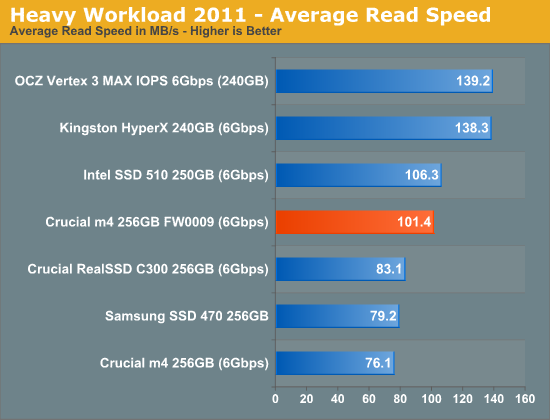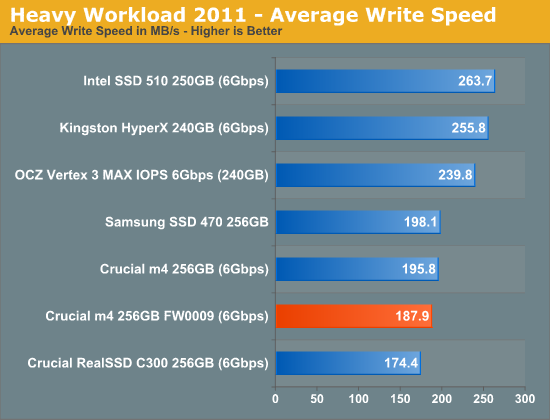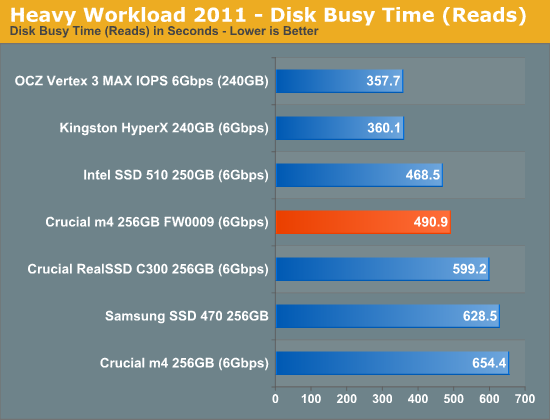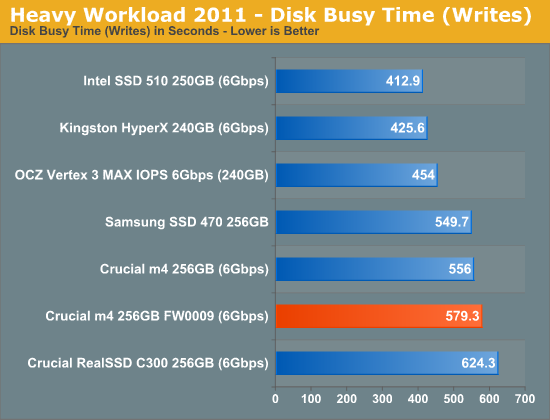The Crucial m4 SSD Update: Faster with FW0009
by Anand Lal Shimpi on August 31, 2011 12:56 AM ESTAnandTech Storage Bench 2011
Last year we introduced our AnandTech Storage Bench, a suite of benchmarks that took traces of real OS/application usage and played them back in a repeatable manner. I assembled the traces myself out of frustration with the majority of what we have today in terms of SSD benchmarks.
Although the AnandTech Storage Bench tests did a good job of characterizing SSD performance, they weren't stressful enough. All of the tests performed less than 10GB of reads/writes and typically involved only 4GB of writes specifically. That's not even enough exceed the spare area on most SSDs. Most canned SSD benchmarks don't even come close to writing a single gigabyte of data, but that doesn't mean that simply writing 4GB is acceptable.
Originally I kept the benchmarks short enough that they wouldn't be a burden to run (~30 minutes) but long enough that they were representative of what a power user might do with their system.
Not too long ago I tweeted that I had created what I referred to as the Mother of All SSD Benchmarks (MOASB). Rather than only writing 4GB of data to the drive, this benchmark writes 106.32GB. It's the load you'd put on a drive after nearly two weeks of constant usage. And it takes a *long* time to run.
1) The MOASB, officially called AnandTech Storage Bench 2011 - Heavy Workload, mainly focuses on the times when your I/O activity is the highest. There is a lot of downloading and application installing that happens during the course of this test. My thinking was that it's during application installs, file copies, downloading and multitasking with all of this that you can really notice performance differences between drives.
2) I tried to cover as many bases as possible with the software I incorporated into this test. There's a lot of photo editing in Photoshop, HTML editing in Dreamweaver, web browsing, game playing/level loading (Starcraft II & WoW are both a part of the test) as well as general use stuff (application installing, virus scanning). I included a large amount of email downloading, document creation and editing as well. To top it all off I even use Visual Studio 2008 to build Chromium during the test.
The test has 2,168,893 read operations and 1,783,447 write operations. The IO breakdown is as follows:
| AnandTech Storage Bench 2011 - Heavy Workload IO Breakdown | ||||
| IO Size | % of Total | |||
| 4KB | 28% | |||
| 16KB | 10% | |||
| 32KB | 10% | |||
| 64KB | 4% | |||
Only 42% of all operations are sequential, the rest range from pseudo to fully random (with most falling in the pseudo-random category). Average queue depth is 4.625 IOs, with 59% of operations taking place in an IO queue of 1.
Many of you have asked for a better way to really characterize performance. Simply looking at IOPS doesn't really say much. As a result I'm going to be presenting Storage Bench 2011 data in a slightly different way. We'll have performance represented as Average MB/s, with higher numbers being better. At the same time I'll be reporting how long the SSD was busy while running this test. These disk busy graphs will show you exactly how much time was shaved off by using a faster drive vs. a slower one during the course of this test. Finally, I will also break out performance into reads, writes and combined. The reason I do this is to help balance out the fact that this test is unusually write intensive, which can often hide the benefits of a drive with good read performance.
There's also a new light workload for 2011. This is a far more reasonable, typical every day use case benchmark. Lots of web browsing, photo editing (but with a greater focus on photo consumption), video playback as well as some application installs and gaming. This test isn't nearly as write intensive as the MOASB but it's still multiple times more write intensive than what we were running last year.
As always I don't believe that these two benchmarks alone are enough to characterize the performance of a drive, but hopefully along with the rest of our tests they will help provide a better idea.
The testbed for Storage Bench 2011 has changed as well. We're now using a Sandy Bridge platform with full 6Gbps support for these tests.
AnandTech Storage Bench 2011 - Heavy Workload
We'll start out by looking at average data rate throughout our new heavy workload test:

Overall performance in our heavy workload is now on par with last year's C300. We don't see huge gains in our heavy suite but Crucial has never really done well here to begin with. At least the numbers are up above the C300. The SF-2281 based Kingston HyperX has a 33% performance advantage here but if you look at the disk busy time below that amounts to around 4 minutes saved over hours of execution. In other words, you'd be hard pressed to tell the difference between nearly any of these drives.


The next three charts just represent the same data, but in a different manner. Instead of looking at average data rate, we're looking at how long the disk was busy for during this entire test. Note that disk busy time excludes any and all idles, this is just how long the SSD was busy doing something:













45 Comments
View All Comments
nandreetta - Wednesday, August 31, 2011 - link
I'm tempted to pick this up while Newegg has it on sale, but I've been trying to convince myself to buy an Intel SSD instead for a while now due to what everyone says about reliability. With a 2007 Santa Rosa MBP, I'll be limited by the slow SATA interface anyway, so reliability trumps speed. It's just hard to justify spending $300 or more on an upgrade rather than saving the money for a new machine when I'm this far outside of AppleCare.Any thoughts, Internet?
FunBunny2 - Wednesday, August 31, 2011 - link
What's most interesting is that we may have another good controller. Marvell has been making them for a while, but not as a preferred vendor for some. A rock solid controller that's not SF or Intel is a good thing.daidaloss - Thursday, September 1, 2011 - link
+1fhaddad78 - Wednesday, August 31, 2011 - link
I'm still rockin my 160GB Intel X25-M SSD. It's hard to imagine the new drivers are faster than what I have now. It's the only drive in my computer and my box boots up lightning fast and apps open in an instant.Coup27 - Thursday, September 1, 2011 - link
fhaddad78 I concur. I am going to be building a small ITX system next month for a friend and I couldn't decide on either 64GB M4, 470 or slightly more expensive 80GB 320. Reading reviews on the 470 and the M4 question their ability to maintain their speed over the months of use.I've had an X25-M 80GB in my current setup for 8 months now running the Optimizer once a week. I decided to do something I've never done to my SSD, which is to benchmark it. After 8 months of use the values were exactly what Anand's graphs showed for my SSD when it was doing the rounds on the reviews.
Think my decsion has been made. Deffinately worth a little extra for the quality of the product.
daidaloss - Thursday, September 1, 2011 - link
My G2 80GB been running for a year and a half with practically the same performance as the moment I've bought it.Intel definitely nailed with the G2 series.
G2 are definitely worth all the money.
danwat12345 - Sunday, November 13, 2011 - link
Yea me to. G2 80GB, still keeps up with the new stuff with random reads on SATA 2!iRoNeTiK - Friday, September 2, 2011 - link
I got the same test results when I updated my m4 128GB my firmware to 0009 as well, thumbs up!METALMORPHASIS - Tuesday, September 6, 2011 - link
And still not ready for prime time.lin41411 - Monday, September 12, 2011 - link
256GB M4 is about $430...1GB $1.67128GB M4 is about $200...1GB $1.56
64GB M4 is about $110...1GB $1.71
the price in China...
so,as a Chinese,I really can not understand why we are low income, but the price is high
T T